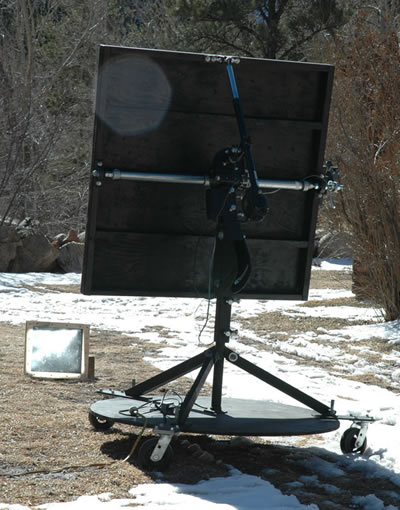There are many applications for heliostats,
here are a few...
* Water heating
* Lighting
* Desalination (Evaporating salt water to make fresh water)
* Producing steam to generate electricity
Here are a few of our experiments.
9X (CSP) Heliostat flat plate collector water heating experiment.
|
9X solar concentrating heliostat focused on flat plate collector. 9 square foot heliostat = 836 watts of potential solar energy. |
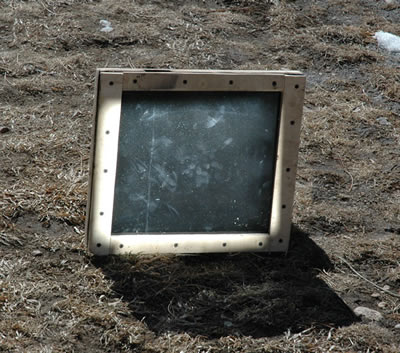 |
The flat plate collector was constructed with 5/8" plywood, thin galvanized sheet metal, drywall screws, silicone caulking, and high temperature black paint. The collector measures 14" x 12" x 1 1/2" |
Heating cycle - Flat plate collector holds 4 lbs water (1/2 gallon)
Ambient air temp 46°F
Altitude 7200 feet
Time |
Temp °F |
Temp change °F (from last measurement) |
Net energy gain BTU |
Net energy gain Watts equiv. |
System Efficiency |
Re-radiation BTU* |
Re-radiation |
0 min |
52 |
||||||
5 min |
88 |
+36 |
144 BTU |
506 |
61% |
-12btu |
42 watts |
10 min |
120 |
+32 |
128 BTU |
449 |
53% |
-24btu |
84 watts |
15 min |
147 |
+27 |
108 BTU |
379 |
45% |
-36btu |
127 watts |
20 min |
170 |
+23 |
92 BTU |
323 |
39% |
-48btu |
169 watts |
25 min |
197 |
+27 |
108BTU |
379 |
45% |
-56btu |
197 watts |
30 min (boiling) |
198 |
+1 |
- |
- |
- |
- |
- |
35 min (boiling) |
198 |
+0 |
- |
- |
- |
- |
- |
* The re-radiation index was taken from the cooling cycle chart below. The collector was removed from the heliostat focal point and temperature measurements were taken every five minutes to see how much heat energy the system was losing due to re-radiation. A collector with smaller surface area or better insulation would reduce re-radiation losses and increase net system efficiency.
Cooling cycle - 4 lbs water (1/2 gallon) in flat plate collector (ambient air temp 46°F)
Altitude 7200 feet
Time |
Temp °F |
Change °F |
BTU loss |
Watts equiv. |
0 min |
197 |
|||
5 min |
182 |
15 |
60 |
211 |
10 min |
169 |
13 |
52 |
183 |
15 min |
157 |
12 |
48 |
169 |
20 min |
146 |
11 |
44 |
155 |
25 min |
137 |
9 |
36 |
127 |
30 min |
129 |
8 |
32 |
112 |
35 min |
122 |
7 |
28 |
98 |
40 min |
115 |
7 |
28 |
98 |
45 min |
108 |
7 |
28 |
98 |
50 min |
102 |
6 |
24 |
84 |
55 min |
97 |
5 |
20 |
70 |
60 min |
93 |
4 |
16 |
56 |
65 min |
89 |
4 |
16 |
56 |
70 min |
85 |
4 |
16 |
56 |
75 min |
80 |
5 |
20 |
70 |
PV / Water heater hybrid
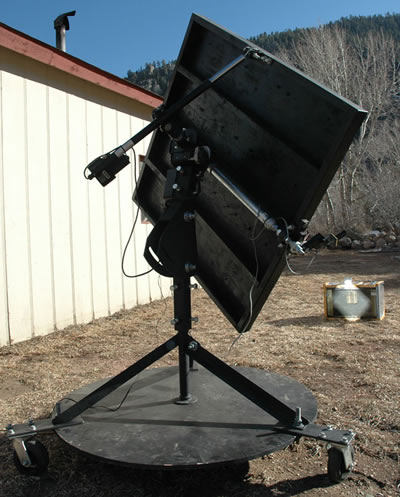 |
The X9 Heliostat focused on an experimental hot water heater / PV collector.
|
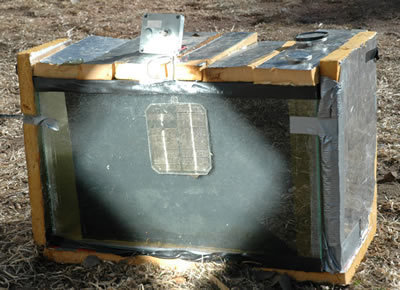 |
A closer view shows that this hydro-thermal / photo-voltaic collector is nothing more than a ten gallon aquarium with a small solar panel submerged in the water in front of the black plate heating element. The solar cell is encapsulated in clear epoxy so it is waterproof. The surrounding water keeps the solar panel from exceeding 160°F. What we don't know is how long the solar panel will hold up under nine times concentrated solar power or '9X CSP'. The solar panel is powering a small gearmotor as a load test to simulate a recirculation pump. |
PV output
|
|
||||||||||||||||||||||||||||||||||||||||||||||||||||||
A wider sample of data would need to be taken to accurately determine the maximum power point of the PV panel at 9X solar concentration and no solar concentration.
A few things that the data does tell us about the PV panel under 9X CSP (9 suns)
- The maximum power point of the PV panel is realized at a greater load (lower resistance).
- The PV panel supplies eleven times more power through a ten ohm load than it does with no solar concentration.
- The PV panel can deliver at least six times more power under 9X solar concentration than it can under no solar concentration. (This is done by comparing the the highest power measurements at one sun and nine suns)
Hot water
10 gallon aquarium
Ambient temperature 50°F
Time |
Temp °F |
Change °F |
BTU |
Watts |
0 min |
39 |
|||
30 min |
50 |
11 |
916 |
537 |
60 min |
63 |
13 |
1083 |
634 |
Lighting
 |
Here is a picture from behind the Heliostat. If you look close you can see the relay mirror and solar spot in the very center of the photo about 120' away. |
 |
Here is a picture looking through my shed window at the target mirror. Clearly visible is the mirror plane of the heliostat. |
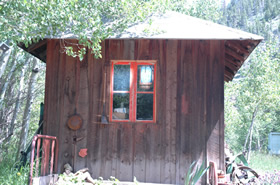 |
Here you can see where the sun has been redirected through the window of the garden shed... |
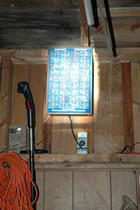 |
Illuminating a small 9 watt solar panel inside . Fine for battery maintenance but not much more. The addition of natural light to a normally dark shed is very nice. |
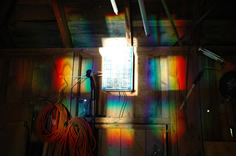 |
Here's a pretty thing. It is amazing how much entertainment value you can get from a heliostat shining through some diffraction paper. |
Water heating
 |
My mom suggested that that we use one of our heliostats to help keep her birdbath thawed out during the winter. |
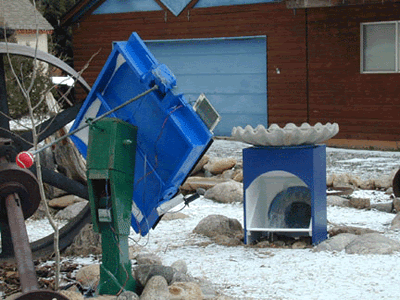 |
We built a plywood stand with a hole cut in the top to set the birdbath over. The mirror that reflects the concentrated solar energy up onto the bottom of the basin is plywood covered with a sheet of reflective mylar. We painted part of the birdbath black on the bottom so that it would absorb more heat. |
 |
Of course, like any heliostat application, this works only when there the sun is out. An electric birdbath heater is the only way to guarantee that it will never freeze. |
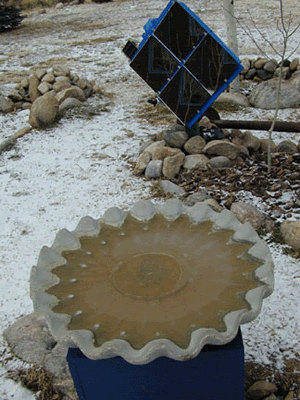 |
We only had a couple of hours of sunshine the day we took these photos so there is only a small circle of thaw right in the middle of the birdbath. Even though the ice may not be completely thawed it is easy to lift out of the basin because the bottom melts first. My mom finds this very convenient since she likes to empty and refill the birdbath every day with fresh water anyway. It is usually impossible to remove the ice from her un-heated birdbath. We also noticed that when there is sun the "heliobath" stays thawed once it has been refilled, even in sub-zero temperatures. This is not the case with her other birdbath which will freeze over in an hour or so. This system would work better if we used a thin metal basin and painted the whole bottom black with a selective solar coating like SOLKOTE from SOLEC company. |

